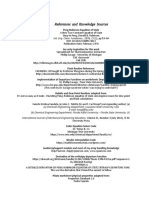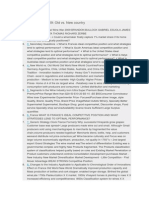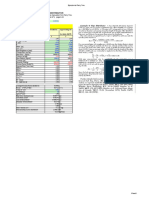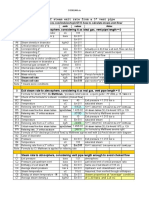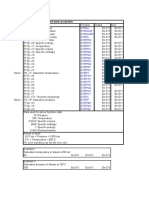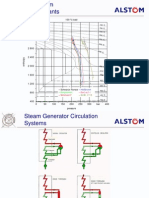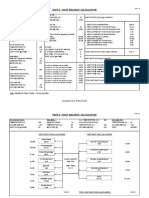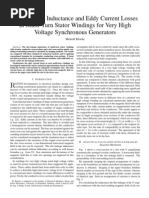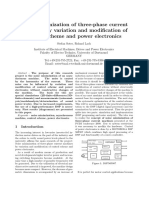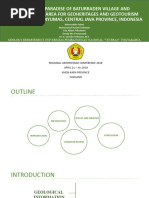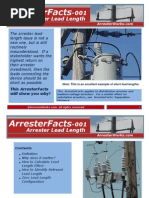Bps-06 NOx Control
Bps-06 NOx Control
Uploaded by
LTE002Copyright:
Available Formats
Bps-06 NOx Control
Bps-06 NOx Control
Uploaded by
LTE002Original Description:
Copyright
Available Formats
Share this document
Did you find this document useful?
Is this content inappropriate?
Copyright:
Available Formats
Bps-06 NOx Control
Bps-06 NOx Control
Uploaded by
LTE002Copyright:
Available Formats
BURNING PRB COAL
Minimize NOx using
only combustion control
You may not have to spend big bucks on an SCR system to reduce your NOx
emissions. The retrot of a 600-MW opposed-wall-red utility boiler with
low-NOx, dual air zone burners and overre air cut the Wyoming PRB
coal burners NOx output nearly in half. The key to the projects success,
from the design stage through nal testing and boiler tuning, was CFD
modeling.
By Craig A. Penterson and Kenneth R. Hules, ScD, Riley Power Inc., a Babcock Power Inc. Company
acing tighter fleetwide NOx limits, a
midwestern utility found itself having
to decide which emissions-control
technologies to install at which plants. As
part of the process, the utility did a technical
and economic analysis of NOx-reduction
options. The analysis suggested that upgrading the combustion control of one of its
plants would avoid having to add an expensive selective catalytic reduction (SCR) or
selective noncatalytic reduction(SNCR) system at the plant and be sufficient to meet
eetwide NOx-reduction goalsbut only if
doing so reduced the plants NOx output by
half.
Babcock Power Inc., through its Worcester, Mass.based subsidiary Riley Power Inc.
(RPI), took on the challenge of reducing the
plants NOx emissions from 0.30 lb/million
Btu (mmBtu) to 0.155 lb/mmBtu, while
maintaining CO levels below 100 ppm and
carbon-in-ash levels below 0.5%.
The boiler in question is opposed-wallfired, originally burned subbituminous
Powder River Basin (PRB) coal exclusively, and came equipped with 56 low-NOx,
dual-register, first-generation Babcock &
Wilcox burners at four elevations. However, due to high localized furnace heat
release rates and excessive slagging, 16 of
the burners (4 per elevation) were removed
from service following startup. The boiler
was designed to generate 4,550,000 lb/hr
of main steam at 2,650 psig and 1,005F,
and 4,281,000 lb/hr of reheat steam at 602
psig and 1,005F. At full load, the plants
turbine-generator produces approximately
600 MW.
A clean-burning design
Major modications to the boilers existing
combustion hardware included installing
upgraded burners, new overre air (OFA),
and rearranging the burners to allow those
at the upper elevation to take their combustion air from the lower three windbox compartments. The OFA nozzles were installed
in the uppermost windbox compartment.
The burner selected for the project uses
RPIs latest low-NOx, dual air zone, controlled-combustion venturi (CCV) burner
technology (Figure 1). The venturi coal
nozzle, low-swirl coal spreader, and ame
stabilizer ring produce a well-attached,
fuel-rich amethe fundamental necessity
for minimizing the formation of both fuel
and thermal NOx.
The use of OFA further stages the combustion process and produces additional
NO x reduction. Typically, up to 25% of
the combustion air can be diverted from
the main burner and introduced above the
top elevation of burners. This reduces the
stoichiometry at the main burner zone and
creates a reducing environment for combustion. Air staging is limited (or not used
at all) on boilers burning high-sulfur coals
and on boilers designed for supercritical
operation due to the possibility of lower
furnace waterwall corrosion.
Separate on/off dampers within each
OFA section control air ow through each
1. The low-NOx, dual air zone burners schematic (L) and hardware (R)
Shroud actuator
(automatic)
Flame scanner
Venturi coal nozzle
Tertiary air swirl
vanes (adjustable)
Ignitor
Burner head
Flame stabilizer ring
Secondary air diverter
Tertiary air diverter
Low-swirl coal spreader
Secondary air flow
control damper
Burner air shroud
Secondary air swirl
vanes (fixed)
Source: Riley Power Inc.
48
www.powermag.platts.com
POWER
| October 2005
BURNING PRB COAL
of the compartments. This results in better
control of the penetration and mixing of the
overfire air over a range of operating
loadsa key factor in optimizing combustion and minimizing CO production
throughout the load range.
The NOx-reducing features of the burner
design include dual combustion-air zones,
the low-swirl coal spreader, and the ame
stabilizer ring. The zoning divides the combustion air into secondary and tertiary air
their design, to obtain data for the furnace
model, and to obtain the burner settings
needed to produce the desired low-NO x
flow patterns for initial settings during
burner and unit shakedown. This reduced
recommissioning time.
Burner models were 2-D simulations
that used aerodynamics only (no combustion) to represent a single burner in
an idealized tunnel furnace that in turn
represented the equivalent firing wall
The modeling simulated the gas flow inside
the burners in terms of its velocities,
turbulence, temperature, pressure, density,
and local chemical composition.
passages, each of which contains swirl vanes
for spin control. Using shrouds and dampers
to independently control the air ow to each
passage improves control of the stoichiometry at the burner discharge and the burners
ability to reduce NOx emissions as well. The
low-swirl coal spreader disperses the pulverized coal into individual streams that enter
the furnace in a helical flow pattern. The
ames produced are longer than those produced by high-swirl coal spreaders. Finally,
the flame stabilizer ring produces a wellattached, tubular-shaped coal ame, which
further reduces NOx emissions.
Analyze this
The design of the burners and their target
furnace were modeled using computational
fluid dynamics (CFD) techniques. The
modeling simulated the gas ow inside the
burners in terms of its velocities, turbulence, temperature, pressure, density, and
local chemical composition.
Two types of steady-state models were
needed to achieve the project goals. One
modeled the individual burners to ne-tune
region of an outside burner. This
approach yielded a tunnel diameter similar in size to the actual firing environment but without the flame-to-flame
interactions that dominate the flow
behavior several throat diameters from
the wall (Figure 2).
The ow pattern in Figure 2 (L) shows a
well-attached, broad, bushy ame. However, streamlines within the quarl show that
primary air (PA) and secondary air (SA)
streams interact strongly with rapid mixing
driven by the high SA swirl relative to the
axial PA ow. As a result, excess oxygen
enters the primary ignition zone, so NOx
production will be high. The ow patterns
in Figure 2 (R), which are expected to be
enlarged slightly by the high reactivity of
the PRB coal, show a longer, more tubular
ame strongly attached to the burner tip.
The second steady-state model was of
the entire furnace and concentrated on OFA
design and performance. The variables on
which the model focused were upper furnace oxygen distribution, CO and carbon
burnout, the effect of different configura-
2. The streamlines of a CFD-modeled single-burner, pre-retrot (L)
and post-retrot (R)
12.99
12.34
11.69
11.04
10.40
9.75
9.10
8.45
7.80
7.15
6.50
5.85
5.20
4.55
3.80
3.26
2.60
1.96
1.30
0.55
0.00
6.34
6.02
5.71
5.39
5.07
4.75
4.44
4.12
3.80
3.49
3.17
2.85
2.54
2.22
1.90
1.54
1.27
0.95
0.68
0.32
0.00
Source: Riley Power Inc.
October 2005
| POWER
tions of mills being out of service on furnace and OFA performance, and possible
approaches for boundary air design to
reduce or eliminate sidewall corrosion,
should it develop.
Because of the left-to-right asymmetry
that results from taking burners out of service, the models of the furnace cover its full
width. Each model uses more than 860,000
brick-like cells to represent the 82-ft-wide
by 51-ft-deep by 184-ft-high furnace volume. More than two-thirds of the cells are
concentrated around the burner openings to
capture reasonable detail of burner flow
patterns, ame structures, and their interactions. Farther away from the burners, the
furnace ow patterns are of a larger scale.
To balance calculation time against ow
detail, the furnace models separated the
pulverized-coal streams to the burners into
three different-sized bins of small, medium,
and large coal particles. This captured most
of the differences in ow behavior among
the variously sized coal particles. The
devolatilization rate and the composition of
volatiles were adjusted for the reactivity of
the particular PRB coal. A two-step reaction system (volatiles to CO to CO 2 )
allowed the realistic simulation of furnace
CO levels from furnace bottom to furnace
exit. Carbon-in-ash (CIA) values were calculated, and small adjustments in the char
burnout reaction rate were made as the base
case simulation progressed. This enabled
the CIA levels of yash at the furnace exit
to remain close to eld data.
Because field-measured values of furnace exit gas temperature (FEGT) and
upper furnace gas temperatures and composition were not available, the base-case
results of the furnace model could not be
validated directly against actual measurements. But it was possible to indirectly validate the model by comparing it to the
model of a pre-retrot furnace with a burner configuration known to produce high
FEGT, as deduced by high steam temperatures and high spray ows.
The FEGT results for the two CFD cases
yielded a difference commensurate with the
back-end heat transfer calculations for the
regular and high-FEGT field setups. No
CFD-based NOx calculations were made.
RPI prefers to rely on regression-analysis
calculations of NO x emissions based on
eld measurements at more than 150 coalred utility units.
In-depth analysis
Figures 3 and 4 show the computed FEGT
and oxygen distribution fields for the preand post-retrot cases. The plots of Figure
3 indicate that the retrot did not create any
49
BURNING PRB COAL
unusual temperature disturbances anywhere
in the furnace and that the incremental
FEGT difference is less than the 50 degrees
F needed to maintain control of ash buildup
in the upper furnace ash. Meanwhile, the
oxygen plots of Figure 4 indicate that,
although the post-retrofit OFA system
made major redistributions of combustion
air and oxygen as part of the NOx-reduction
process, the oxygen distribution in the
upper furnace (and particularly at the furnace exit) is more uniform for the postretrot case.
CFD furnace modeling addressed
potential problems that might surface from
the burner zone air staging that RPI
expected would be required to meet the
projects NO x -reduction goal. It is well
known that opposed-fired utility furnaces
can suffer sidewall corrosion even without
air staging (that is, without OFA), primarily in the middle of the sidewalls at upper
burner elevations. Although sidewall
wastage had not been a problem at this
unit, because burner zone air staging is
part of the NO x -reduction strategy, the
potential for sidewall corrosion may
become more severe in the post-retrofit
situation. Accordingly, a plan to minimize
this potential should be in place. Figure 5
shows the computed gas oxygen content at
the sidewalls. A comparison of Figure 6
(L) to Figure 6 (R) indicates that the postretrofit firing arrangement decreased the
peak sidewall heat flux while increasing
the area of elevated heat flux. This was
due to the spreading out of the combustion process by overfire air.
Last but not least, CFD furnace modeling also helped control project costs.
Another post-retrofit furnace model containing additional wing OFA ports indicated this alternate OFA layout was not as
effective in this unit at upper furnace oxygen mixing and distribution as originally
thought. The CFD modeling informed the
engineering decision to discard this more
complex and costly OFA layout in favor of
the design shown in Figure 4.
Passing with ying colors
The low-NO x burners and OFA were
installed during a scheduled outage of the
plant in the spring of 2002. During the outage, prior to burner installation, the burners
were preassembled on the ground and
hoisted to the burner deck for installation
into the windbox as a one-piece design,
minimizing the construction effort inside
the windbox. They were sized to t within
the existing burner throat openings, avoiding additional modications to the boilers
pressure parts.
50
3. Computed gas temperatures (F) for the pre-retrot (L) and postretrot (R) furnace
3200
3200
2900
2900
2600
2600
2300
2300
2000
2000
1700
1700
1400
1400
1100
1100
800
800
500
500
200
200
Source: Riley Power Inc.
4. Computed gas oxygen percentage for the pre-retrot (L) and postretrot (R) furnace
10
10
Source: Riley Power Inc.
5. Computed sidewall oxygen percentage for the pre-retrot (L) and
post-retrot (R) furnace
5.0
5.0
4.5
4.5
4.0
4.0
3.5
3.5
3.0
3.0
2.5
2.5
2.0
2.0
1.5
1.5
1.0
1.0
0.5
0.5
0.0
0.0
Source: Riley Power Inc.
POWER
| October 2005
BURNING PRB COAL
6. Post-retrot sidewall heat ux (Btu/hr-ft2) for pre-retrot (L) and
post-retrot furnaces (R)
Table 2. The results of additional
post-project performance testing
-160000
-160000
-144000
-144000
-128000
-128000
-112000
-112000
Operating
parameter
Gross generation
(MW)
Feedwater flow
(lb/hr)
-96000
-96000
Main steam temp (F)
1,001
1,012
Main steam spray
(lb/hr)
Reheat steam temp
(F)
Reheat steam spray
(lb/hr)
162,000
1,003
1,006
78,000
31,000
-80000
-80000
-64000
-64000
-48000
-48000
-32000
-32000
-16000
-16000
Total air flow (lb/hr)
Average FEGT (F)
Coal flow (lb/hr)
Pre-retrofit Post-retrofit
600
600
4,308,500
4,066,000
664,000
648,000
6,145,000
5,983,000
2,337
2,315
3.1
0.3
3.1
0.158
10
40
0.06
0.09
0.9
Economizer O2 (%)
Source: Riley Power Inc.
NOx emissions
(lb/million Btu)
CO emissions
(ppmdv)
Table 1. Comparing test results to project performance targets
Carbon in ash (%)
Operating parameter
Pre-retrofit baseline
Performance target
Performance test
Unit load (MW)
600
600
600
Overfire air (%)
20
14
NOx emissions (lb/million Btu)
0.3
<0.185
0.158
CO emissions (ppm)
10
<100
40
0.06
<2.0
0.09
Unburned carbon in flyash (%)
Source: Riley Power Inc.
Source: Riley Power Inc.
7. The impact of OFA ow on NOx emissions (in ppm), as a function
of the number of mills out of service (MOOS)
2 MOOS
1 MOOS
NOx measured at economizer out (lb/mmBtu)
0.30
0.25
0.20
0.15
0.10
0
10
15
20
OFA ratio (%)
Source: Riley Power Inc.
After the unit was returned to service
and operating close to full load, coal
lines were balanced using variable oriOctober 2005
| POWER
Opacity (%)
fices installed in them during the retrofit. No additional testing for coal fineness was done. Once the coal lines were
balanced, the unit underwent optimization testing and tuning for one week.
CFD facilitated this process as well, by
providing initial starting-point settings
for the burners that were close to the settings determined at completion of the
burner tuning.
As Table 1 indicates, the new burners
met all of the projects performance targets.
Table 2 compares the results of additional
pre- and post-retrofit performance testing
on the boiler at full load. Fossil Energy
Research Corp. (Laguna Hills, Calif.) did
flue-gas emissions measurements and isokinetic flyash sampling at the outlet ducts
of the boilers economizer. Table 2 confirms that the retrofit reduced NOx emissions by nearly 50%.
As expected, NO x emissions decrease
as the OFA ratio increases (Figure 7).
Average NOx emissions of around 0.155
lb/mmBtu, and as low as 0.138 lb/mmBtu
(with an OFA ratio of 20%), were
achieved. The number of coal mills in
operation also had an impact on NO x
emissions. Keeping seven millsrather
than six of the eight availablein service
produced lower NO x emissions because
the low-NOx burners were sized for operation with seven mills. Operating with six
mills produced higher burner velocities
and more turbulent mixing, and higher
NOx as a result.
51
You might also like
- Chemistry Project Class-XII (2021-22) - Investigatory ProjectDocument16 pagesChemistry Project Class-XII (2021-22) - Investigatory ProjectSamuel Kumar85% (296)
- 36 Questions TranscriptDocument109 pages36 Questions TranscriptEVAN BLIZZARD94% (17)
- PR1978 Workbook July-24-2017Document1,085 pagesPR1978 Workbook July-24-2017rewqNo ratings yet
- Boiler OEE Calculation Ver1.00Document37 pagesBoiler OEE Calculation Ver1.00bkprodhNo ratings yet
- Soil WashingDocument19 pagesSoil WashingLTE002No ratings yet
- Calculation Radial Forced Slot Wedge-Paper - 40Document6 pagesCalculation Radial Forced Slot Wedge-Paper - 40SISWANTONo ratings yet
- 50 AMP Smart Energy Management System Model 800: IntellitecDocument16 pages50 AMP Smart Energy Management System Model 800: IntellitecLawrence KucharekNo ratings yet
- Global Wine War 2009Document8 pagesGlobal Wine War 2009serapNo ratings yet
- Software Developments and News: Spreadsheet Model To Design of Hazardous Waste IncineratorsDocument12 pagesSoftware Developments and News: Spreadsheet Model To Design of Hazardous Waste IncineratorsLanCezNo ratings yet
- HW GasDocument5 pagesHW GastauqeerNo ratings yet
- STM Dosing and Feeding Systems For Air Pollution ControlDocument42 pagesSTM Dosing and Feeding Systems For Air Pollution ControlJoseph RileyNo ratings yet
- Gas AnalyzerDocument5 pagesGas Analyzerengine5No ratings yet
- Guid For Air Leak in VacuumDocument4 pagesGuid For Air Leak in Vacuumscranderi100% (1)
- Vacuum Pump Selection For RMGDocument15 pagesVacuum Pump Selection For RMGvaibhavd123No ratings yet
- fouling factor 중량 비체적: ft^2/Btu m^2/Kcal lb/ft kg/m lb/ft^3 kg/m^3 0.3689556791 1.4881889764 16.018732594Document27 pagesfouling factor 중량 비체적: ft^2/Btu m^2/Kcal lb/ft kg/m lb/ft^3 kg/m^3 0.3689556791 1.4881889764 16.018732594김종민No ratings yet
- Coalescer Separator General DescriptionDocument1 pageCoalescer Separator General DescriptionRanaweera AriyamanjulaNo ratings yet
- Pressure Drop CalcualtionDocument11 pagesPressure Drop CalcualtionDuong ThaoNo ratings yet
- Article GT GE General ElectricDocument2 pagesArticle GT GE General ElectricguerrezNo ratings yet
- Gas Receiver Sizing Application: InputsDocument2 pagesGas Receiver Sizing Application: InputsShahzaibUsmanNo ratings yet
- Spreadsheet New ThermalDocument2 pagesSpreadsheet New ThermalAnindya ananda putriNo ratings yet
- Pipe DistribuidoresDocument4 pagesPipe Distribuidoresjunaidmateen2345No ratings yet
- Simple BoxDocument104 pagesSimple BoxTÙNGNo ratings yet
- HRSG Cal Pinch ApproachDocument13 pagesHRSG Cal Pinch Approachmyungkwan haNo ratings yet
- Steel Elbow Weight & PricesDocument8 pagesSteel Elbow Weight & PricesRavinderNo ratings yet
- Pan Steam HumidifierDocument1 pagePan Steam HumidifierRahul ChandrawarNo ratings yet
- Sensitivity U01 U02 JUNE03Document9 pagesSensitivity U01 U02 JUNE03Adil EL FARDAOUINo ratings yet
- SCR Catalyst Development of A Mara System For Aig Tuning Since 1989 Design ofDocument34 pagesSCR Catalyst Development of A Mara System For Aig Tuning Since 1989 Design ofSteve WanNo ratings yet
- Interpretation of Natural Draft Burner Data.: FiringDocument1 pageInterpretation of Natural Draft Burner Data.: Firingmehul10941No ratings yet
- HRSG1 (终版)Document120 pagesHRSG1 (终版)Atif KhanNo ratings yet
- Calcul Coalescer L-LDocument4 pagesCalcul Coalescer L-LChitu Ionut-LaurentiuNo ratings yet
- WHB PERHITUNGAN Coba 1Document24 pagesWHB PERHITUNGAN Coba 1Ayu permata sariNo ratings yet
- TMAH Wet Etching of Al PDFDocument6 pagesTMAH Wet Etching of Al PDFAllen AllendeNo ratings yet
- Steam VentDocument4 pagesSteam VentShameer MajeedNo ratings yet
- MX-20105ABC - Rev.1 (Stirrer - Agi Mix Tank D) - EnglishDocument4 pagesMX-20105ABC - Rev.1 (Stirrer - Agi Mix Tank D) - EnglishidilfitriNo ratings yet
- Summary of Anchor / Nozzle Movements For Vertical VesselDocument17 pagesSummary of Anchor / Nozzle Movements For Vertical VesselArindomNo ratings yet
- Expansion Vessel CalculationDocument4 pagesExpansion Vessel CalculationTsouki TsoukiNo ratings yet
- ZEECO Boiler Burner Data SheetDocument11 pagesZEECO Boiler Burner Data SheetValiNo ratings yet
- EXAMPLE-Steam and Water PropertiesDocument1 pageEXAMPLE-Steam and Water PropertiesRahul ChandrawarNo ratings yet
- @ 60 Degc 100 WT % H2ODocument30 pages@ 60 Degc 100 WT % H2OMildawwgNo ratings yet
- Lab 06 Study On Washing Chemical Calculation On ExcelDocument2 pagesLab 06 Study On Washing Chemical Calculation On Excelasifaib.bmNo ratings yet
- Gas Conditioning System Specification Sheet: Process InformationDocument3 pagesGas Conditioning System Specification Sheet: Process InformationNITIN P SHAHNo ratings yet
- Role of CFD in SCR NOX Reduction PerformanceDocument8 pagesRole of CFD in SCR NOX Reduction PerformanceMadusuthanan SababathyNo ratings yet
- Boiler Control Philosophy R00Document6 pagesBoiler Control Philosophy R00Raj Kumar TiwariNo ratings yet
- Turbine Combustion Kinetics PSR-1 : CVODE Starts at Line 100 On EXCEL SheetDocument14 pagesTurbine Combustion Kinetics PSR-1 : CVODE Starts at Line 100 On EXCEL SheetcymyNo ratings yet
- Perhitungan Furnace Efesiesnsi Furnace CDU 11-F-101Document40 pagesPerhitungan Furnace Efesiesnsi Furnace CDU 11-F-101Aditya PratomoNo ratings yet
- New Concept For Utilization COG & BFGDocument2 pagesNew Concept For Utilization COG & BFGAhmad FaisalNo ratings yet
- Ultrasonic Horn DesignsDocument5 pagesUltrasonic Horn DesignssolveaudioNo ratings yet
- EFFICIENCY by BEE FormulaDocument8 pagesEFFICIENCY by BEE FormulaVenkateswara Rao DoodalaNo ratings yet
- Alstom NID PräsentationDocument41 pagesAlstom NID Präsentation41176711411100% (1)
- Instrumentation in UreaDocument6 pagesInstrumentation in UreaGaurav MishraNo ratings yet
- Calculating Humid Air DataDocument1 pageCalculating Humid Air DataRahul ChandrawarNo ratings yet
- CalculationDocument17 pagesCalculationavmurugan870% (1)
- Clcs Air Fuel CombustionDocument37 pagesClcs Air Fuel CombustionkanchanNo ratings yet
- Hydrogen Analysis Resource Center:: Hydrogen Compressibility (Z) at Different Temperatures (C) and Pressures (Mpa)Document6 pagesHydrogen Analysis Resource Center:: Hydrogen Compressibility (Z) at Different Temperatures (C) and Pressures (Mpa)Ashwani KumarNo ratings yet
- Psuextension Particle Size 4mm MetricDocument8 pagesPsuextension Particle Size 4mm MetricRed RedNo ratings yet
- CentrifugalCompressorPower-SI UnitsDocument4 pagesCentrifugalCompressorPower-SI UnitsSuryaprakash DigavalliNo ratings yet
- Specification - Perklone EXT™ Catalyst Grade BannerChemicals-meets UOP-Refinery - Irwan PtrisDocument1 pageSpecification - Perklone EXT™ Catalyst Grade BannerChemicals-meets UOP-Refinery - Irwan PtrisfajaradityadarmaNo ratings yet
- Stacks and ChimneysDocument1 pageStacks and Chimneysวิทวัส นิเทียนNo ratings yet
- Insulation Thickness by UOPDocument4 pagesInsulation Thickness by UOPOmar EzzatNo ratings yet
- Burner Data SheetDocument6 pagesBurner Data SheetLuis Eduardo NavasNo ratings yet
- CS46 - Basic Immersion Firetube ModelDocument22 pagesCS46 - Basic Immersion Firetube ModelYasin YILDIZNo ratings yet
- Super Critical PresentationDocument46 pagesSuper Critical PresentationSam100% (1)
- Fired Boilers: 2.1 Design PrinciplesDocument6 pagesFired Boilers: 2.1 Design PrinciplesEric TingNo ratings yet
- FD Aerofoil 1590x2640Document4 pagesFD Aerofoil 1590x2640Prakash WarrierNo ratings yet
- Unit-3: Heat Balance Calculation: 9/8/2008 Section: Calculations By: PROCESS DEPTDocument2 pagesUnit-3: Heat Balance Calculation: 9/8/2008 Section: Calculations By: PROCESS DEPTjoe_kudoNo ratings yet
- Latest Low NOx Combustion TechnologyDocument7 pagesLatest Low NOx Combustion Technology95113309No ratings yet
- ZH - 2005 RCDocument99 pagesZH - 2005 RCLTE002No ratings yet
- Bridges - Asia-22-25 02 10Document84 pagesBridges - Asia-22-25 02 10LTE002100% (1)
- High PerformanceDocument3 pagesHigh PerformanceLTE002No ratings yet
- Biomass To Ethanol ProcessDocument132 pagesBiomass To Ethanol ProcessLTE002No ratings yet
- Cal Methodology - Energy Saving - Electrical - HouseholdDocument15 pagesCal Methodology - Energy Saving - Electrical - HouseholdLTE002No ratings yet
- Simulation of High-Speed FillingDocument13 pagesSimulation of High-Speed FillingLTE002No ratings yet
- Trigger Sprayer Dynamic Systems ModelDocument5 pagesTrigger Sprayer Dynamic Systems ModelLTE002No ratings yet
- 49 Structure Porosity of Flocculated ADDocument8 pages49 Structure Porosity of Flocculated ADLTE002No ratings yet
- Paper - 84 Magnetic FormingDocument8 pagesPaper - 84 Magnetic FormingLTE002No ratings yet
- Paper 43Document8 pagesPaper 43manasrinuNo ratings yet
- Paper - 5 Noise MinimizationDocument5 pagesPaper - 5 Noise MinimizationLTE002No ratings yet
- PrehistoricDocument8 pagesPrehistoricapi-244125744No ratings yet
- Acti9 Ic60 Catalogue PDFDocument124 pagesActi9 Ic60 Catalogue PDFDionysios KoutsouvelisNo ratings yet
- Computing Learners Resource Pack (Corrected)Document76 pagesComputing Learners Resource Pack (Corrected)Tejasvini HummingwaveNo ratings yet
- Is Iec 61196 1 107 2005Document13 pagesIs Iec 61196 1 107 2005Shivangi BhardwajNo ratings yet
- Impact of Quantum Computing On CryptographyDocument6 pagesImpact of Quantum Computing On CryptographySanthosh DheerajNo ratings yet
- Fractures and Principles in Management (Thari Raman - S Conflicted Copy 2016-05-07Document59 pagesFractures and Principles in Management (Thari Raman - S Conflicted Copy 2016-05-07Suganeya UdiasoorianNo ratings yet
- La Villa Fact Sheet 2021-2022-UpdatedDocument4 pagesLa Villa Fact Sheet 2021-2022-Updatedsweta suresh ganvirNo ratings yet
- Ema Garp Fund - q2 2011 ReportDocument9 pagesEma Garp Fund - q2 2011 ReportllepardNo ratings yet
- A Test Case of Abu Dhabi Airport: Supply Chain ManagementDocument8 pagesA Test Case of Abu Dhabi Airport: Supply Chain ManagementAhmed AlshaerNo ratings yet
- 504-C-002 Deethanizer HDS Rev 0Document9 pages504-C-002 Deethanizer HDS Rev 0Anupriya1913No ratings yet
- The Great Paradise of Baturraden Village and Surrounding Area For Geoheritages and Geotourism Potential of Banyumas, CeDocument29 pagesThe Great Paradise of Baturraden Village and Surrounding Area For Geoheritages and Geotourism Potential of Banyumas, CeVicho RamadhanNo ratings yet
- Implementing IS-IS Over IPv6 On IOS-XE and IOS-XRDocument14 pagesImplementing IS-IS Over IPv6 On IOS-XE and IOS-XRachmmygn9No ratings yet
- Product Sheet GSM-5140Document1 pageProduct Sheet GSM-5140Kebo ElhaqNo ratings yet
- Oxygen Toxicity: January 2006Document11 pagesOxygen Toxicity: January 2006Dana, BNNo ratings yet
- Line Coding and Block CodingDocument12 pagesLine Coding and Block CodingBhuvan ThakurNo ratings yet
- ArresterWorks Facts-001 Arrester Lead LengthDocument11 pagesArresterWorks Facts-001 Arrester Lead Lengthnshj196No ratings yet
- Top - 200 ExportersDocument6 pagesTop - 200 ExportersblakeherlinNo ratings yet
- THE MAGIC TALISMAN ART OF ZACHARY SELIG - Sollano 16 Exhibition, Sollano 16, San Miguel de Allende, Guanajuato, Mexico, April 1, 2015 - CatalogueDocument27 pagesTHE MAGIC TALISMAN ART OF ZACHARY SELIG - Sollano 16 Exhibition, Sollano 16, San Miguel de Allende, Guanajuato, Mexico, April 1, 2015 - CatalogueZACHARYSELIGNo ratings yet
- Henshall Kanji Mnemonics1Document17 pagesHenshall Kanji Mnemonics1Victoria PetrovaNo ratings yet
- Pyrethrin ConcDocument6 pagesPyrethrin ConcdandiNo ratings yet
- Visions 2 The Science of The Cards Astrology & SpiritualityDocument81 pagesVisions 2 The Science of The Cards Astrology & SpiritualityJK100% (6)
- Dashavidha Pareeksha With PareekshabhavaDocument60 pagesDashavidha Pareeksha With PareekshabhavaAbiskar AdhikariNo ratings yet
- GuruShakti - Narasimha KavachamDocument6 pagesGuruShakti - Narasimha Kavachamihtnasakirah918No ratings yet
- QJR Ring Sizing Guide No-Printer-RequiredDocument1 pageQJR Ring Sizing Guide No-Printer-RequiredVikki LKNo ratings yet
- List of Emc Tests Un Ece r10 Rev.6Document4 pagesList of Emc Tests Un Ece r10 Rev.6mirassouNo ratings yet
- Parts Range Guides: Filters Description Part No. Change Interval / H Qty Notes EngineDocument4 pagesParts Range Guides: Filters Description Part No. Change Interval / H Qty Notes EngineAstrit StratiNo ratings yet


